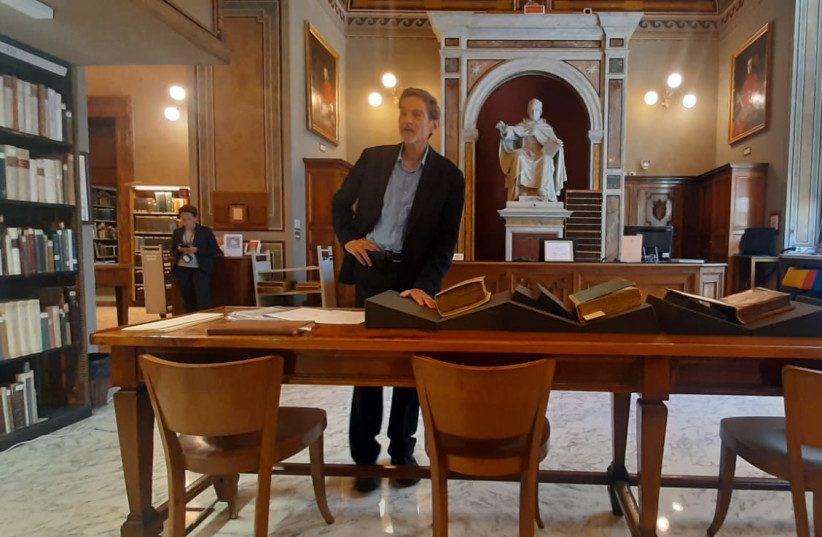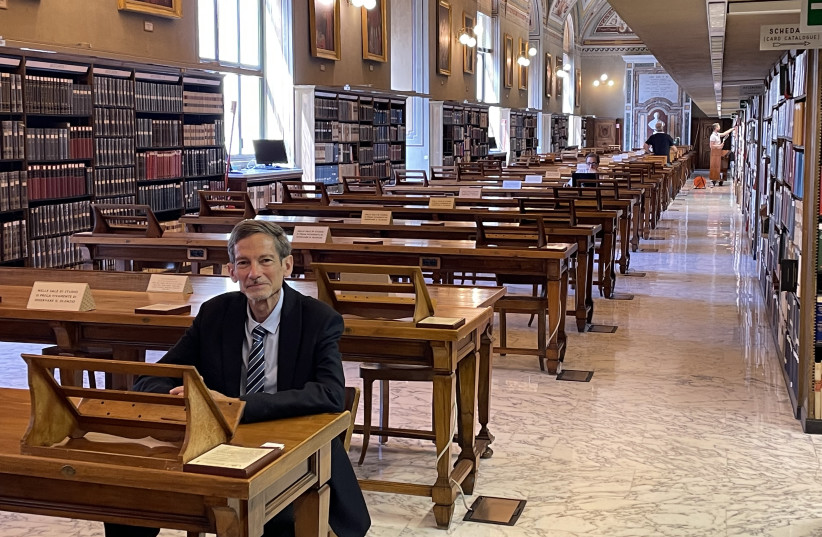by Zvika Klein
A group of over 20 Christian and Jewish clergy and scholars from around the world came together to delve into the treasures of the Vatican's Hebrew manuscript collection.
 |
Prof. David Golinkin in the Vatican Apostolic Library.
(photo credit: DAVID GOLINKIN)
|
In the heart of the Vatican, where ancient corridors echo with centuries of history, an extraordinary gathering took place last week. A group of over 20 Christian and Jewish clergy and scholars from around the world had come together for a once-in-a-lifetime experience – a captivating journey through time, delving into the treasures of the Vatican's Hebrew manuscript collection.
Rabbi Prof. David Golinkin, President of The Schechter Institutes, and Dr. Adolfo Roitman, the renowned Curator of the Dead Sea Scrolls, stood as the esteemed Israeli representatives, eagerly joining the seminar celebrating 30 years of diplomatic relations between the Holy See and the State of Israel.
With a sense of awe, the participants immersed themselves in a remarkable experience, exploring Hebrew manuscripts that date back to the 10th century. This ecumenical and academic conference, co-sponsored by the Vatican Library and Argentina’s Seminario Rabinico Latinoamericano (The Latin American Rabbinical Seminary of the Conservative Movement), became a momentous occasion for interreligious dialogue and the discovery of shared cultural heritage.
Golinkin, a distinguished expert in Talmud, Midrash, and Jewish law, eagerly unveiled the significance of the Vatican Library's Hebrew manuscript collection. "The Vatican Library holds a rich and varied collection of over 800 Hebrew manuscripts, including extremely old and rare manuscripts of the Talmud Yerushalmi, Sifra on Leviticus," he shared with The Jerusalem Post upon returning to Israel this week.
The intrigue deepened as Golinkin took the participants on a captivating journey through time, shedding light on Christian censorship of printed versions of the Talmud and other Jewish books. With a thought-provoking gaze, he asked, "Why was the Catholic Church so afraid of the Talmud?

Complex history of Jewish-Catholic relations
What methods were used to censor the printed versions of the Talmud? How did Jews deal with the censorship?" His lectures drew the participants into a realm of historical complexities and the struggle for intellectual freedom.
According to Golinkin, Christian censorship of the Talmud began in 1553. Initially, early editions of the Talmud printed in Italy, like the famous Venice edition of 1520, did not undergo censorship. “However, in 1553, after a public burning of the Talmud in Rome, the Pope decided to impose censorship. This meant expurgating certain passages before printing or blacking them out afterward,” he explained.
“The censors, often former Jews who had converted to Catholicism, were responsible for this task. They focused on passages related to Jesus, Mary, and anything they perceived as connected to Christianity. However, their censorship was not always accurate, and many times, they expurgated passages that were unrelated to Christianity,” he said.
"Every book that was censored is signed by the censor, sometimes in Hebrew, always in Latin characters, saying his name," Golinkin explained.
"So much of the censorship ended up not making any sense at all, but they had this list of forbidden words and phrases and went through the entire Talmud and changed all those words,” he shared.
For example, the word min (heretic) was frequently replaced with "Samaritan," even though the context might not support this change. The censors had a list of forbidden words, and they would replace them systematically, sometimes leading to illogical alterations. This censorship continued until the 19th century, affecting not only the Talmud but hundreds of other Hebrew books as well. I provided specific examples of censored passages during my lecture.”
Roitman, equally enthralled by the atmosphere, offered his own insights during the Seminar. As a leading authority on Second Temple Jewish Literature and Religion, he masterfully delved into the textual variants present in the Dead Sea Scrolls versus the Masoretic and the LXX versions (Codex Vaticanus). The audience was spellbound by his discussion on Qumran's exegesis, particularly the mysterious Pesher Habakkuk and 11QMelchizedek (11Q13).
However, beyond the academic pursuits, the Seminar became a true testament to the power of collaboration. Jewish and Christian scholars sat side by side, leafing through ancient Hebrew manuscripts, fostering mutual understanding and appreciation for each other's cultural heritage. "This is something that has never happened before," Golinkin proclaimed, capturing the essence of the unprecedented gathering.
Throughout history, Jews and Catholics have faced complex relations, with moments of cooperation and tension. Medieval Europe witnessed discriminatory policies and anti-Jewish sentiment under Catholic rule, including forced expulsions and segregation.
Theological differences and historical misunderstandings also contributed to strained relations. In modern times, efforts towards dialogue and reconciliation, such as the Second Vatican Council's declaration "Nostra Aetate," have fostered a more nuanced relationship. The recent landmark Seminar on Hebrew manuscripts at the Vatican exemplified the ongoing quest for understanding and cooperation between these two communities.
The Vatican Apostolic Library, known as the 'Pope's Library,' embraced the participants in its timeless embrace. With manuscripts and materials dating back to the 5th century, it held the legacy of a profound journey through time – a testament to the enduring connection between Jewish heritage and the Vatican's rich historical legacy.
In 2008, three Israeli scholars published a complete catalog of all the Hebrew manuscripts at the Vatican. This catalog includes all the Hebrew manuscripts in their possession until 2008.
“Although they have acquired new collections since then, which haven't been cataloged yet, there is no hiding of the existing manuscripts,” Golinkin said of the Vatican, adding that when people talk about “hiding content,” they might be “referring to archival materials, like records related to the Pope's actions during the Holocaust, which have not been made public.
But in terms of manuscripts, they are making a genuine effort to make everything available,” Golinkin said.
As the participants bid farewell to the Vatican's hallowed halls, Golinkin offered his reflections on the historic gathering, stating, "This seminar was a rare and exceptional opportunity for Jewish and Christian scholars to come together, explore ancient Hebrew manuscripts, and deepen our understanding of our shared intellectual and cultural heritage. The spirit of cooperation and mutual respect that permeated the conference was truly inspiring, and I believe it will leave a lasting impact on our future interreligious dialogues."
Golinkin concluded with an example of how invested the Vatican is in publishing the Hebrew texts. “During my second lecture, a librarian approached me with a recently discovered page of the Talmud Yerushalmi. He showed me a photograph of it, and he asked if I would be interested in publishing it.” He added that “they are eager to share their discoveries with the public. The Vatican Library even has its own academic journal, and they proposed that I publish it there. I gladly accepted the offer.
“What's truly remarkable is the collaboration between Jews and Christians studying Hebrew manuscripts together in the Vatican Library, which is an entirely new and unprecedented experience,” he concluded emotionally.
Zvika Klein
Source: https://www.jpost.com/judaism/article-752403
No comments:
Post a Comment